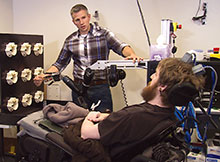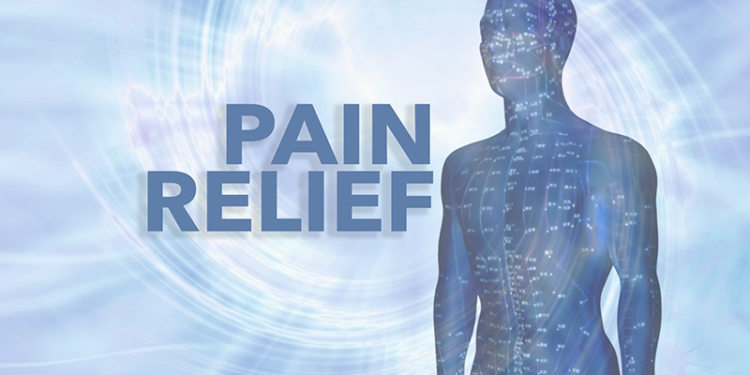
A frame grab of the video showing Copeland move the APL arm, courtesy of DARPA.
A Defense Advanced Research Projects Agency (DARPA)-funded research team has demonstrated a technology-for the first time ever in a human-that allows an individual to experience the sensation of touch through a robotic arm that he controls with his brain. By enabling two-way communication between brain and machine-outgoing signals for movement and inbound signals for sensation-the technology could ultimately support new ways for people with paralysis to engage with each other and with the world. The study was published online October 13 in Science Translational Medicine.
“DARPA has previously demonstrated direct neural control of a robotic arm, and now we’ve completed the circuit, sending information from a robotic arm back to the brain,” said Justin Sanchez, PhD, director of DARPA’s Biological Technologies Office and the program manager for its Revolutionizing Prosthetics program. “This new capability fundamentally changes the relationship between humans and machines.”
The volunteer for the study, 28-year-old Nathan Copeland, has lived with quadriplegia from the upper chest down since a 2004 car accident in which his neck was broken and his spinal cord was injured. He underwent brain surgery in 2015, at which time he was connected to a brain-computer interface (BCI) developed by researchers at the University of Pittsburgh (Pitt) and the University of Pittsburgh Medical Center (UPMC). Four microelectrode arrays-each about half the size of a shirt button-were laced in his brain, two in the motor cortex and two in the sensory cortex regions that correspond to feeling in his fingers and palm. The researchers ran wires from those arrays to a robotic arm developed by the Applied Physics Laboratory (APL) at Johns Hopkins University. The APL arm contains sophisticated torque sensors that can detect when pressure is being applied to any of its fingers, and can convert those physical “sensations” into electrical signals that the wires carry back to the arrays in Copeland’s brain to provide precise patterns of stimulation to his sensory neurons. In the very first set of tests, in which researchers touched each of the robotic fingers while Copeland was blindfolded, he was able to report with nearly 100 percent accuracy which finger was being touched.
Copeland can feel pressure and distinguish its intensity to some extent, though he cannot identify whether a substance is hot or cold. “I can feel just about every finger-it’s a really weird sensation,” Copeland said about a month after surgery. “Sometimes it feels electrical and sometimes it’s pressure, but for the most part, I can tell most of the fingers with definite precision. It feels like my fingers are getting touched or pushed.”
“The most important result in this study is that microstimulation of sensory cortex can elicit natural sensation instead of tingling,” said study co-author Andrew B. Schwartz, PhD, distinguished professor of neurobiology and endowed chair in systems neuroscience in the Pitt School of Medicine, and a member of the Pitt Brain Institute. “This stimulation is safe, and the evoked sensations are stable over months. There is still a lot of research that needs to be carried out to better understand the stimulation patterns needed to help patients make better movements.”
This is not the Pitt-UPMC team’s first attempt at a BCI. Four years ago, study co-author Jennifer Collinger, PhD, an assistant professor in Pitt’s Department of Physical Medicine and Rehabilitation and a research scientist for the VA Pittsburgh Healthcare System R&D Center of Excellence, and the team demonstrated a BCI that helped Jan Scheuermann, who has quadriplegia caused by a degenerative disease. Before that, Tim Hemmes, paralyzed in a motorcycle accident, reached out to touch hands with his girlfriend.
The lead researcher for this latest study, Robert Gaunt, PhD, assistant professor of physical medicine and rehabilitation at Pitt, explained that everything about the work is meant to make use of the brain’s natural, existing abilities to give people back what was lost but not forgotten. “The ultimate goal is to create a system which moves and feels just like a natural arm would,” he said.
Editor’s note: This story was adapted from materials provided by DARPA and Pitt-UPMC. To watch a video of Copeland identifying finger sensations, visit www.youtube.com/watch?v=A4BR4Iqfy7w.




